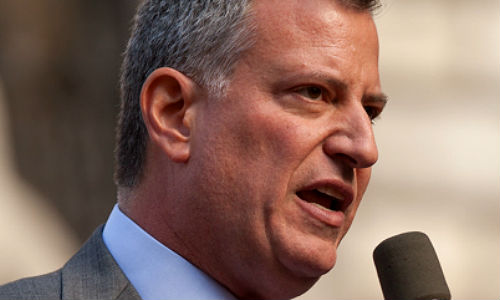 Mayor Bill de Blasio announced that New York City saw the fewest traffic fatalities on record last year, driven by a 32 percent drop in pedestrian fatalities. This marks the fourth consecutive year of declining traffic deaths under Vision Zero. Since 2013, fatalities have dropped 28 percent. Pedestrian deaths have plummeted by nearly half—45 percent. These mark the lowest levels since record keeping began in 1910. The Mayor made the announcement at an event at NYPD’s Central Garage in Woodside, Queens where he thanked City workers responsible for implementing Vision Zero.
Mayor Bill de Blasio announced that New York City saw the fewest traffic fatalities on record last year, driven by a 32 percent drop in pedestrian fatalities. This marks the fourth consecutive year of declining traffic deaths under Vision Zero. Since 2013, fatalities have dropped 28 percent. Pedestrian deaths have plummeted by nearly half—45 percent. These mark the lowest levels since record keeping began in 1910. The Mayor made the announcement at an event at NYPD’s Central Garage in Woodside, Queens where he thanked City workers responsible for implementing Vision Zero.
In 2017, 214 people, 101 of them pedestrians, were lost in traffic crashes. This compares to 231 total fatalities and 148 pedestrians in 2016. These reductions are sharply bucking the national trend. According to the National Highway Traffic Safety Administration (NHTSA), traffic fatalities nationwide have increased more than 13 percent from 2013-2016.
“Vision Zero is working. The lower speed limit, increased enforcement and safer street designs are all building on each other to keep New Yorkers safe. Now we must deepen this work. Not even a single tragedy on our streets is acceptable, and we’ll keep fighting every day to protect our people,” said Mayor de Blasio.
“Thanks to the incredible work of everyone at DOT, the NYPD, and our agency partners, the first four years of Vision Zero have been the safest ever on our city streets. Vision Zero has truly saved lives — of family members, friends, neighbors and fellow New Yorkers,” said DOT Commissioner Polly Trottenberg. “In 2017, under the Mayor’s leadership, DOT’s work helped fuel a historic drop in pedestrian fatalities, including through a record number of street safety redesigns and turning treatments, and by reprogramming a record number of traffic signals to give pedestrians a head start in crosswalks. However, the number of lives lost on our streets is still too high, including the increases in fatalities we saw this year among cyclists, drivers and motorcyclists. We know we have much more work to do to fully achieve Vision Zero.”
“These year-end Vision Zero statistics show that, since the initiative began, our combined efforts have significantly reduced traffic-related fatalities. We’ve made the streets of our City safer, and that has saved lives,” said NYPD Commissioner James P. O’Neill. “But the stats also show us that there’s more for the members of the Vision Zero Task Force to do, and we will – together.”
“Instilling the critical message of Vision Zero in our licensees, alongside the very real risks of unsafe driving, has never been more important,” said TLC Commissioner Meera Joshi. “We’ve achieved an impressive number of milestones in our fourth year of working toward the goal of zero traffic fatalities, including the induction of a record number of drivers and businesses into our safety Honor Roll. But this has only deepened our resolve to ensure that we have the safest taxi and for-hire industries in the world.”
“Ensuring the safety of students, families, educators and school staff always comes first, and by increasing enforcement, having speed cameras in school zones and providing curriculum to schools, New York City has taken essential steps to prevent injuries as people travel to and from school each day,” said Schools Chancellor Carmen Fariña. “We will continue to work tirelessly across City agencies to ensure the safety of all New Yorkers, while providing a safe commute for students, families, and school staff.”
“City fleet operations has shared in the overall improvement in safety with a major reduction in fatal events since 2014 when Mayor de Blasio began Vision Zero,” said DCAS Commissioner Lisette Camilo. “Thanks to the Safe Fleet Transition Plan that DCAS and City fleet agencies completed in 2017, we will be procuring even safer vehicles and trucks moving forward to build on this progress.”
“Vision Zero has become a national model for street safety, and 2017 was yet another record year in our city,” saidHealth Commissioner Dr. Mary T. Bassett. “As we step closer to our goal of zero traffic fatalities, I thank Mayor de Blasio and our sister agencies for working with us to address this vital public health issue with unprecedented determination and focus.”
Among notable Vision Zero achievements in 2017:
A Steep Decline in Pedestrian Deaths: As part of Vision Zero, New York City committed to strategies to protect pedestrians, the most vulnerable street users. In 2017, the 32 percent decline in pedestrian fatalities was the steepest-ever one-year percentage decline in the City’s recorded history. For decades, pedestrians usually made up the majority of New York City’s traffic fatalities. The 101 pedestrian fatalities in 2017 comprised 47% of all fatalities, the smallest-ever proportion of traffic deaths in New York City.
A Single Fatality Among School-Aged Pedestrian Children (aged 5-17): No family should ever have to feel the tragic loss of a child from a traffic crash. This year, the City continued to redesign corridors and intersections, strengthened automated enforcement around schools and taught the Cross This Way curriculum in public schools. On August 16th, a 13-year-old boy was tragically struck on an East Harlem street, and became New York City’s only child pedestrian fatality for the entire year. While still too many, one fatality is the fewest ever among children under 17. The previous five years had seen an average of 7 schoolchildren killed per year. As recently as 2004, 17 children were killed.
Fewest Ever Fatalities in Queens: Traffic fatalities were down in all boroughs except Brooklyn, with Queens leading with a new record low in traffic deaths. In Queens, 2017 saw 59 fatalities compared to 65 in 2016, a 9 percent decline. The previous record low in Queens was 63 fatalities in 2011.
Continued Strong Traffic Enforcement: As part of ongoing Vision Zero enforcement, NYPD Traffic officers issued more than 50,000 summonses to drivers who failed to yield to pedestrians or cyclists in 2017 — more than four times the pre-Vision Zero annual average. Over the same period, officers issued nearly 150,000 speeding summonses, and automated speed cameras issued nearly 1.2 million Notices of Liability in 2017, with more than 50% issued at Vision Zero Priority Locations. Continuing trends from prior years, the Taxi & Limousine Commission increased traffic safety enforcement in 2016, focusing on behaviors like speeding and distracted driving. The agency partnered with the NYPD to increase LIDAR speed enforcement training among TLC officers, allowing the agencies to work together to respond to speeding complaints.
Dusk and Darkness Initiative: In 2017, DOT continued to partner with the NYPD and the Taxi & Limousine Commission on a second annual Dusk and Darkness enforcement and education campaign during the fall and winter evening hours that are most dangerous to pedestrians. Before the first campaign launched in October of 2016, severe crashes involving pedestrians increased by nearly 40 percent in the early evening hours compared to crashes outside the fall and winter. Already, over the first two months of the current Dusk and Darkness initiative, pedestrian fatalities have decreased to 17 from 30 over the same period in 2016, which in turn was a decrease from 41 over the same pre-initiative period in 2015.
A Safer NYC Fleet: In 2017, the Department of Citywide Administrative Services (DCAS) completed its Safe Fleet Transition Plan (SFTP) – updating specifications with an eye towards safety for all City fleet vehicles. Through the SFTP, 160 types of vehicles will be procured with improved safety outfitting, including 450 new vehicles now using automatic braking. In 2017, the City spent more than $370 million on vehicles and expects the new safety specifications will help influence a national marketplace for safer vehicles and trucks. The initiative was completed in partnership with the US DOT Volpe Center, which had also assisted DCAS in its pioneering requirements for rear and side under-ride protection (“side guards”) for all City trucks. Side guards have been shown to reduce cyclist fatalities by 60% and pedestrian fatalities by 20% in side-impact collisions with trucks.
Safer For-Hire Vehicles: In October, the Taxi & Limousine Commission (TLC) honored 420 drivers and 25 businesses for their exemplary safety records, the highest number of honorees in all four years of the event. Safety Honor Roll drivers have no crashes involving an injury or fatality, no moving violations, and no TLC rule violations for at least four years. In February the TLC also approved the final version of its fatigued driving prevention rules, which set daily and weekly hour limits for drivers to help keep tired drivers off the road. TLC continued to hold driver outreach meetings at licensed For-Hire Vehicle (FHV) bases and taxi garages throughout the city, highlighting protected bike lanes, high-risk driving behavior that can lead to crashes, and the crucial role that professional drivers play in promoting a culture of safe driving.
Safety Improvement Projects: The City completed 114 street safety engineering projects in 2017, more than double the pre-Vision Zero annual average, with 76 projects at Priority Locations. More than 350 safety engineering projects have been completed since the start of Vision Zero, with more than 250 at Priority Locations.
Leading Pedestrian Intervals (LPIs): As has been reported, DOT this year installed 832 new LPIs to give pedestrians a “head start” in crosswalks and protect them from turning vehicles. More than half of the new LPIs are in Senior Pedestrian Focus Areas. The City has now installed 2,334 LPIs, increasing their number by seven-fold since the start of Vision Zero.
Turning Safety Improvements: In 2016, Mayor de Blasio had announced the use of new left-turn safety treatments as part of Vision Zero. In 2017, 110 intersections received improvements to reduce the speed of left-turning drivers, with nearly 220 intersections since the start of Vision Zero. 53 locations received Turning Safety Signal Treatments last year, including Split Phases to give pedestrians, cyclists and drivers dedicated times to proceed through intersections. Since the start of Vision Zero, DOT has installed more than 150 new Turning Safety Signal Treatments.
Traffic Signal Retiming: DOT adjusted traffic signal phases around the city to discourage speeding and align with the safer 25MPH citywide speed limit. When signals are retimed, drivers exceeding speed limits encounter more red lights. DOT retimed signals along more than 135 miles of streets in 2017, and has retimed them on more than 400 miles of City streets since the start of Vision Zero.
Making Cycling Safer: The City installed 25 miles of protected bike lanes in 2017, the most of any year and more than triple the pre-Vision Zero annual average. More than 180 miles of dedicated cycling space (conventional and protected bicycle lanes) have been installed since the start of Vision Zero, with a bicycle network now nearing 1,200 miles. This year, DOT released its Safer Cycling report, which found that the rapid growth in the number of New Yorkers cycling – doubling in the last decade — has made bicycling safer in New York City. This year’s increase in fatalities among cyclists was nevertheless troubling; the study’s findings about cycling deaths and serious injury are helping guide DOT’s ambitious plans for cycling infrastructure in 2018, including Manhattan’s first-ever two-way protected crosstown bike lane on 13th Street (opening in advance of the 2019 L train shutdown) and consideration of additional protected bike lanes along other Manhattan crosstown streets.
Transforming Queens Boulevard and Woodhaven/Cross Bay Boulevard: This year, DOT completed its third phase of street redesign along Queens Boulevard in Rego Park and Forest Hills with numerous safety improvements, including 2.6 protected bike lane miles. Once known as “the Boulevard of Death,” Queens Boulevard in 2017 had a third consecutive year without a single pedestrian or cyclist fatality. Meanwhile, in November, DOT and the MTA unveiled Select Bus Service along Woodhaven and Cross Bay Boulevards; in addition to faster and more reliable bus commutes, the transformation of one of Queens’ most crash-prone streets includes dramatic pedestrian safety improvements.
“Vision Zero’s substantial impact on public health and safety is a testament to our City agencies and community partners coming together to solve a critical urban challenge,” said Brooklyn Borough President Eric Adams. I commend Mayor de Blasio, DOT Commissioner Trottenberg, and NYPD Commissioner O’Neill for their efforts to make Brooklyn’s roads safer for everyone. As pedestrian deaths have substantially decreased, we should be mindful of the continued threats to cyclists across the borough, particularly in heavily trafficked areas without bicycle paths. I look forward to continue working with our partners across the City as well as transportation advocates to ensure our borough remains a safe place for drivers, cyclists, and pedestrians alike.”
“This is a safer city as a result of Vision Zero,” said Manhattan Borough President Gale A. Brewer. “There is still room to cut the death rate further– especially among cyclists. I thank the DOT and NYPD for their effort and their continued vigilance.”
“One fatality is one too many, but as a supporter of Mayor de Blasio’s Vision Zero, it is encouraging to see how the plan has been successful in reducing, for the fourth consecutive year, the number of traffic-related deaths on our roads and streets,” said State Senator Jose Peralta. “It is my hope that in 2018 we are finally able to pass my proposal to expand the school zone speed camera program. This is all just about protecting New Yorkers. Together we made and are making progress..”
“Our commitment to pedestrian safety is reflected in our legislation and budget. As a walkable city, we must continue to work hard to keep up our progress in achieving our Vision Zero goals. I look forward to working with Speaker Johnson, my colleagues in the Council and the Administration in this new session,” said Council Member Ydanis Rodriguez.
“With national trends showing a tragic rise in traffic fatalities every year, it is heartening to see that New York City’s comprehensive approach to traffic safety is not only changing behaviors, but truly saving lives,” said Council Member Debi Rose. “Vision Zero has not always been a popular or easy-to-implement set of policies, but it has resulted a downward trend in fatalities citywide, to their lowest levels in more than a century. We will continue to work together to reduce these numbers reduced to zero, because every traffic death is a preventable tragedy.”
“Queens Boulevard is proof that longstanding notions of intractable problems can be solved with determination, perseverance and fresh thinking,” said New York City Council Member Jimmy Van Bramer. “I am proud of our work on Queens Boulevard and throughout the City to lower the traffic fatalities. I applaud Mayor de Blasio and Commissioner Trottenberg’s efforts and will continue working to make the dream of Vision Zero become a reality.”
“This news of life-saving progress in NYC is inspiring to communities across the nation, as more than 30 cities have followed the City’s lead by committing to Vision Zero,” said Leah Shahum, Director of the Vision Zero Network, a national nonprofit supporting local efforts. “NYC’s improvements show us that a firm commitment to Vision Zero principles and actions do indeed make a difference in keeping people safe. As we look ahead, we count on NYC to continue to show strong leadership and stepped-up action to prioritize safety over speed in advancing Vision Zero.”
“That fatalities have fallen for a fourth straight year in New York — at a time when traffic deaths are on the rise across the nation — is a testament to the City’s commitment to Vision Zero,” said Paul Steely White, executive director of Transportation Alternatives. “The unprecedented drop in pedestrian deaths in particular is proof that the Department of Transportation’s data-driven approach is working.”
For more information about the de Blasio Administration’s Vision Zero initiative, please see www.nyc.gov/visionzero.
Become a Harlem Insider!
By submitting this form, you are consenting to receive marketing emails from: Harlem World Magazine, 2521 1/2 west 42nd street, Los Angeles, CA, 90008, https://www.harlemworldmagazine.com. You can revoke your consent to receive emails at any time by using the SafeUnsubscribe® link, found at the bottom of every email. Emails are serviced by Constant Contact








